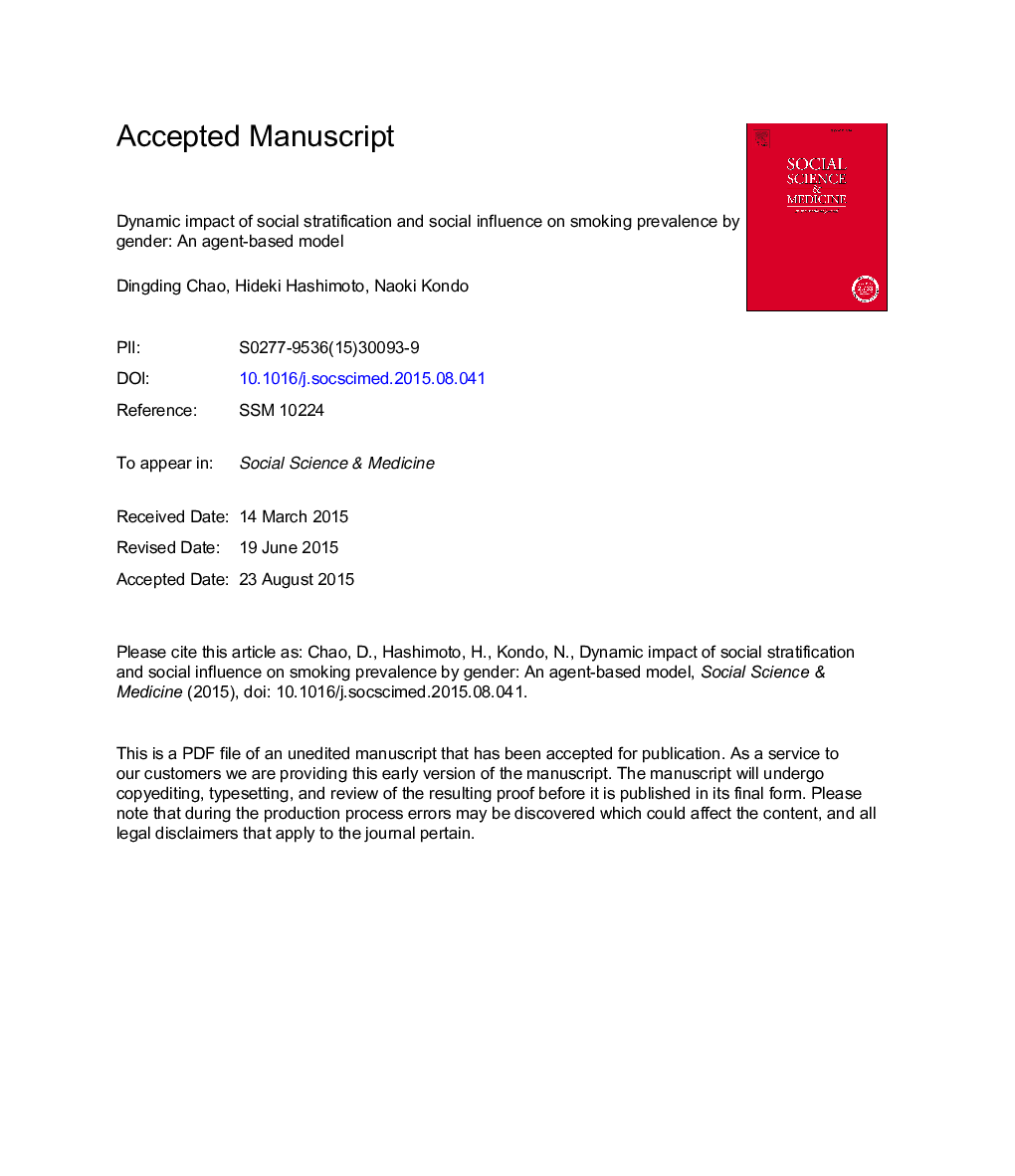| کد مقاله | کد نشریه | سال انتشار | مقاله انگلیسی | نسخه تمام متن |
|---|---|---|---|---|
| 7331301 | 1476022 | 2015 | 52 صفحه PDF | دانلود رایگان |
عنوان انگلیسی مقاله ISI
Dynamic impact of social stratification and social influence on smoking prevalence by gender: An agent-based model
ترجمه فارسی عنوان
تاثیر پویای طبقه بندی اجتماعی و تأثیر اجتماعی بر شیوع سیگار کشیدن بر اساس جنسیت: یک مدل مبتنی بر عامل
دانلود مقاله + سفارش ترجمه
دانلود مقاله ISI انگلیسی
رایگان برای ایرانیان
کلمات کلیدی
مدل مبتنی بر عامل، تفاوت جنسیتی، سیگار کشیدن، نفوذ اجتماعی، طبقه بندی اجتماعی،
ترجمه چکیده
با تمرکز ویژه بر تفاوت های جنسیتی در حساسیت به نفوذ اجتماعی رفتارهای دیگران، ما یک مدل مبتنی بر عامل ایجاد کردیم تا بررسی کنیم که چگونه تفاوت های اجتماعی و اقتصادی بین گروه های جنسیتی و درون گروه ها بر تغییرات شیوع سیگار تاثیر می گذارد. مدل پایه توسعه یافته ما نسبتا تغییرات روند واقعی را با گروه های جنسیتی در 5 سال گذشته در ژاپن به دست آورده است. آزمایش های ضد فاکتور با مدل توسعه یافته نشان داد که بستن تنوع درون و بین جنسیتی در وضعیت اجتماعی-اقتصادی تاثیر محدودی بر کاهش شیوع سیگار کشیدن دارد. برعکس، تفاوت های اجتماعی و اقتصادی بیشتر باعث کاهش شیوع در میان مردان شد، اما این کاهش در زنان را مانع شد. سناریوی مخالف با برابری حساس جنسیتی به نفوذ اجتماعی در میان زنان به سطح مردان، کاهش قابل توجهی در شیوع زنان بدون تغییر کاهش شیوع نر نشان داد. نتایج شبیه سازی ممکن است توضیح جایگزینی از تفاوت های رو به رشد در شیوع سیگار کشیدن را افزایش دهد، با وجود بهبود رفاه و رفاه در بسیاری از کشورهای پیشرفته، و پیشنهاد می کند که سیاست های توزیع مجدد ممکن است عواقبی ناشی از افزایش شکاف بهداشتی داشته باشد. در عوض، سیاست اجتماعی برای کاهش فشارهای اجتماعی به سیگار کشیدن و حمایت از مداخلات برای افزایش انعطاف پذیری به فشار هدف قرار دادن جمعیت آسیب پذیر (در این مطالعه، زنان) یک راهبرد موثرتر در مبارزه با اپیدمی تنفسی و بسته شدن شکاف بهداشتی خواهد بود.
موضوعات مرتبط
علوم پزشکی و سلامت
پزشکی و دندانپزشکی
سیاست های بهداشت و سلامت عمومی
چکیده انگلیسی
With a special focus on gender-bound differences in the susceptibility to social influence of surrounding others' behaviors, we developed an agent-based model to explore how socioeconomic disparity between and within gender groups affects changes in smoking prevalence. Our developed base model reasonably reproduced the actual trend changes by gender groups over the past 5 years in Japan. Counterfactual experiments with the developed model revealed that closing within- and between-gender disparities in socioeconomic status had a limited impact on reducing smoking prevalence. To the contrary, greater socioeconomic disparity facilitated the reduction in prevalence among males, but it impeded that reduction in females. The counterfactual scenario with equalizing gender-bound susceptibility to social influence among women to men's level showed a dramatic reduction in female prevalence without changing the reduction in male prevalence. Simulation results may provide alternative explanation of the growing disparity in smoking prevalence despite improved welfare equality observed in many developed countries, and suggest that redistribution policies may have side effects of widening health gap. Instead, social policy to reduce social pressures to smoking and support interventions to enhance resilience to the pressure targeting the vulnerable population (in this study, women) would be a more effective strategy in combating the tobacco epidemic and closing the health gap.
ناشر
Database: Elsevier - ScienceDirect (ساینس دایرکت)
Journal: Social Science & Medicine - Volume 147, December 2015, Pages 280-287
Journal: Social Science & Medicine - Volume 147, December 2015, Pages 280-287
نویسندگان
Dingding Chao, Hideki Hashimoto, Naoki Kondo,
